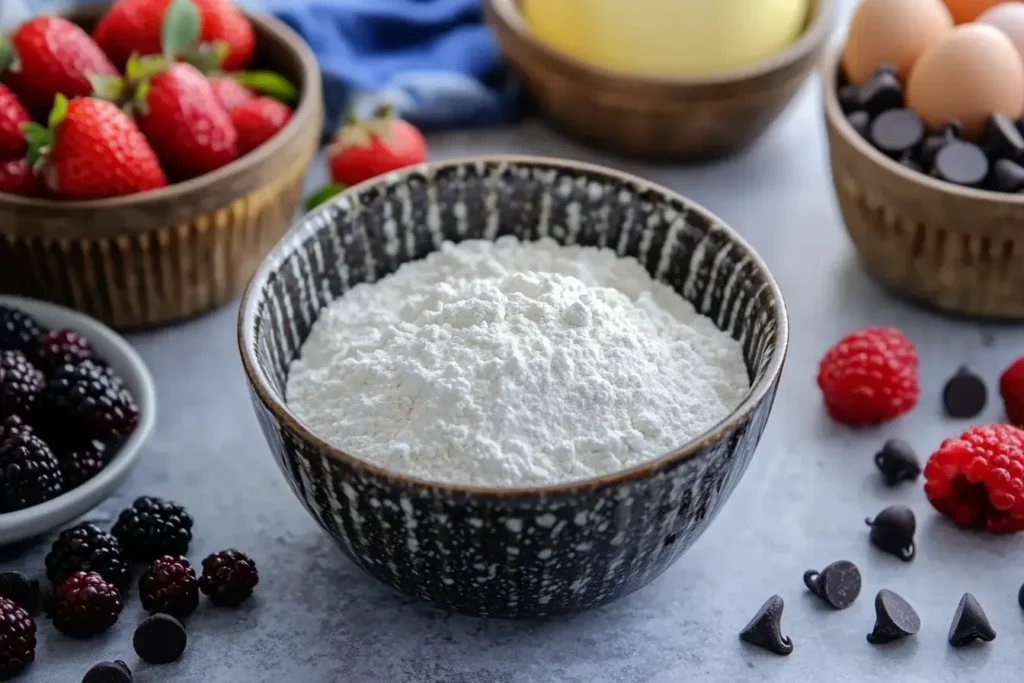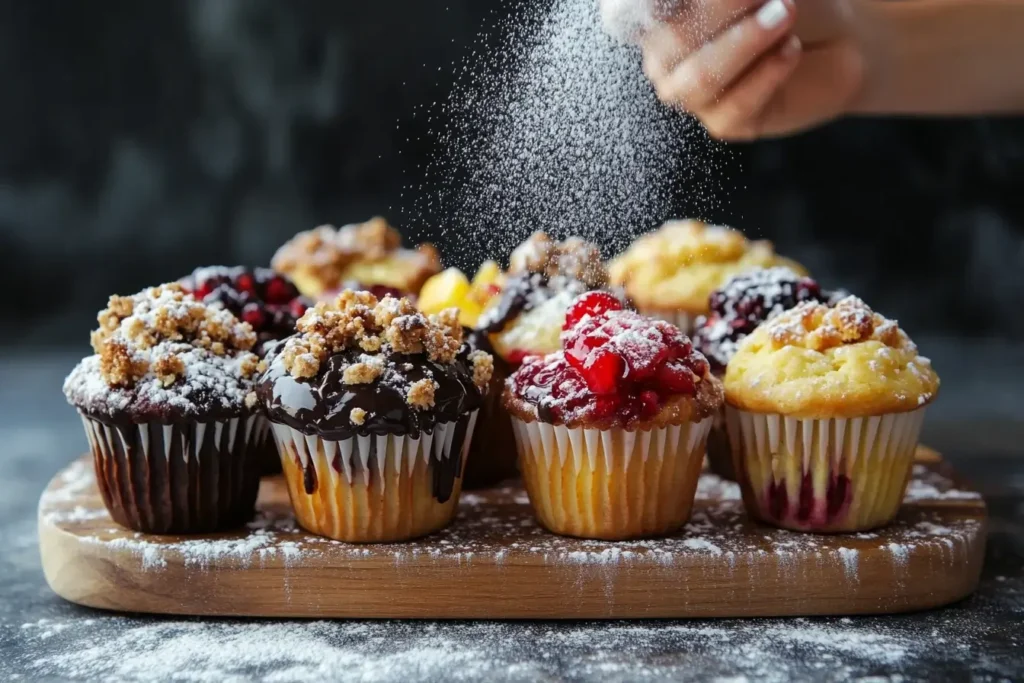Muffins should be soft, fluffy, and packed with moisture, but many home bakers struggle with dry, crumbly results. The good news? There are simple techniques to ensure your muffins turn out perfectly every time. From using the right fats to controlling baking temperature, every step matters.
So, what is the secret to moist muffins? It all comes down to selecting the best ingredients, mixing the batter correctly, and storing them properly to maintain freshness. Whether you’re baking classic blueberry muffins or rich chocolate varieties, these expert tips will help you achieve bakery-quality results at home.
Understanding Moisture in Muffins
Moisture: The Secret to Delicious, Moist Muffins
Moisture is the heart and soul of moist muffins, transforming their texture and creating a delightful mouthfeel that leaves you craving another bite. When muffins are perfectly moist, they’re tender and slightly springy, avoiding the dreaded crumbly or dry texture. Moisture comes primarily from liquid ingredients like milk, water, and oils, which interact with the flour to create a well-hydrated batter. Achieving this balance ensures your muffins turn out soft and flavorful every time.
The science of moisture retention is equally important. As muffins bake, liquids evaporate, and proteins set to create structure. Controlling timing and temperature is crucial for locking in just the right amount of moisture while ensuring the batter cooks evenly. These small adjustments can make all the difference in creating irresistible, moist muffins.
Common Causes of Dry Muffins
Dry muffins are a universal baking frustration, but understanding the causes helps avoid them. Some of the most common culprits include:
- Overmixing the Batter: Vigorous stirring can develop too much gluten, leading to dense, dry muffins.
- Incorrect Baking Time or Temperature: Baking too long or at a high temperature causes excessive evaporation, leaving muffins parched.
- Not Enough Liquid Ingredients: Skimping on milk, oil, or other liquids results in a batter that lacks the moisture needed to hydrate the flour properly.
- Using Low-Fat Substitutes: While healthier alternatives are tempting, they often lack the richness and moisture of traditional ingredients.
Understanding these pitfalls sets the foundation for perfect muffins every time. In the next part, we’ll explore the essential ingredients that make a world of difference in achieving moist and fluffy muffins.
Essential Ingredients for Secret Moist Muffins
Using Oil vs. Butter
One of the biggest debates in baking is whether to use oil or butter. For muffins, oil is often the secret weapon for moistness. Unlike butter, which is solid at room temperature, oil stays liquid, creating a consistently moist texture. Common choices include vegetable oil, canola oil, and even olive oil for a more robust flavor.
Butter, while adding a rich taste, can make muffins slightly drier due to its lower fat content. A great compromise is to use a mix of both oil and butter—getting the flavor from butter and the moisture from oil. For example, banana muffins made with oil often have a soft and tender crumb that stays moist for days.
Importance of Eggs and Dairy Products
Eggs and dairy are pivotal to achieving the perfect moist muffin. Eggs act as a binder, providing structure while locking in moisture. Large eggs are standard in most recipes, but you can enhance moisture by adding an extra yolk or using room-temperature eggs.
Dairy products like milk, yogurt, or buttermilk add richness and help maintain moisture. Buttermilk, in particular, is a game-changer due to its acidity, which helps tenderize the gluten in flour. If you’re aiming for ultra-moist muffins, swap regular milk with full-fat yogurt or buttermilk for the best results.
Enhancing Moisture with Fruits and Vegetables
Ever wondered why carrot cake or zucchini bread always seems so moist? Incorporating fruits and vegetables into your muffin batter is a fantastic way to boost moisture naturally. Grated zucchini, mashed bananas, and applesauce are popular options that also add flavor.
For instance, applesauce not only replaces some of the fat in recipes but also keeps muffins fresh longer. Similarly, blueberries and strawberries release juices during baking, making fruit muffins wonderfully moist. Keep in mind to adjust the sugar content when using sweet fruits.

Baking Techniques for the Secret of Moist Muffins
Mixing Methods That Retain Moisture
The way you mix your batter plays a huge role in creating moist muffins. Overmixing can develop too much gluten, leading to muffins that are dense and dry. To avoid this, use the “muffin method”—combine your wet ingredients in one bowl and dry ingredients in another, then gently fold them together. Stop mixing as soon as the flour is just incorporated; even a few lumps in the batter are fine!
If you’re adding ingredients like fruits or nuts, toss them in a bit of flour before folding them in. This trick helps distribute them evenly and prevents them from sinking to the bottom, ensuring every bite is consistent and moist.
The Right Baking Temperature and Time
Temperature and timing are critical when it comes to baking moist muffins. Start by baking at a high temperature, like 400°F (200°C), for the first five minutes. This helps the muffins rise quickly, forming a beautiful dome. After that, lower the temperature to 350°F (175°C) to bake the centers evenly without drying them out.
Always check for doneness with the toothpick test. Insert a toothpick into the center of a muffin—if it comes out with a few moist crumbs, they’re ready to come out of the oven. Avoid overbaking, as this can rob your muffins of their moisture and make them crumbly.
Prepping Muffin Liners and Tins for Best Results
How you prepare your muffin tins can also influence the outcome of your moist muffins. Non-stick or silicone liners are excellent choices for retaining moisture and ensuring easy release. If you’re skipping liners, lightly grease the tin, but don’t overdo it—too much oil can cause the muffins to fry on the edges instead of bake properly.
For an extra moisture boost, create a humid baking environment. Place an oven-safe dish filled with water on the bottom rack while baking. The steam helps maintain moisture levels and ensures the muffins bake evenly. By following these techniques, you’ll be well on your way to baking irresistibly moist muffins every time.
Adjustments for Specific Muffin Types
Secret for a Moist Chocolate Muffin
Unlocking the secret for a moist chocolate muffin starts with the right balance of ingredients. High-quality cocoa powder enhances the rich, deep flavor, but moisture retention is just as important. To keep chocolate muffins soft and tender, use a combination of fats like oil and full-fat yogurt or sour cream. These ingredients add richness while preventing dryness.
For an extra boost of moisture, fold in chocolate chips or chunks. As they melt during baking, they create pockets of gooey chocolate that enhance both flavor and texture. Another trick? Swap part of the white sugar for brown sugar—its molasses content helps keep muffins soft and moist. Finally, a light sprinkle of sea salt before baking enhances the chocolate flavor, making each bite truly unforgettable.
Tips for Extra-Moist Fruit Muffins
Fruit muffins can easily dry out if the fruit juices evaporate too quickly. The key is to keep the fruit juicy and ensure the batter is thick enough to retain moisture. Coating fresh or frozen fruit in flour before mixing helps prevent sinking and preserves moisture in every bite.
For citrus muffins, brushing a simple syrup glaze made from lemon juice and sugar over warm muffins locks in moisture and boosts flavor. Berry muffins benefit from mixing some of the berries into the batter while reserving a few for the top, creating a bakery-style presentation while maintaining a moist texture.
Gluten-Free and Vegan Moisture Hacks
Gluten-free and vegan muffins often struggle with dryness, but with a few smart substitutions, they can be just as soft and delicious as traditional muffins. Using almond flour or oat flour improves moisture retention compared to other gluten-free alternatives. Adding xanthan gum or psyllium husk enhances texture and helps the muffins hold together.
For extra moist vegan muffins, swap eggs with mashed bananas, applesauce, or flaxseed “eggs.” These ingredients not only replace eggs but also contribute to moisture. Additionally, plant-based milks like almond or soy milk work well, especially when combined with oil to prevent dryness. By making these adjustments, you can create flavorful, moist muffins that everyone can enjoy!
Post-Baking Tips to Keep Muffins Moist
Storing Muffins Properly to Keep Them Moist
Proper storage is critical to keeping muffins moist after baking. Storing muffins properly ensures they maintain their soft texture and delicious flavor for days. Once your muffins have completely cooled, place them in an airtight container to prevent them from drying out. To avoid sogginess, line the container with a paper towel and place another one on top of the muffins. This method absorbs excess moisture while preventing them from becoming too dry.
If you plan to enjoy your muffins over several days, refrigerate those made with fresh fruit or dairy-based fillings. For longer storage, freeze your moist muffins in a resealable freezer bag. When ready to eat, thaw them at room temperature or microwave them for a few seconds to bring back their soft texture.
Reheating Without Drying Them Out
Reheating muffins correctly is essential for maintaining their moisture. The quickest method is wrapping a muffin in a damp paper towel and microwaving it for 10–15 seconds—this helps prevent dryness. Alternatively, warm them in the oven at a low temperature (around 300°F or 150°C) for 5–10 minutes. Covering them with aluminum foil while reheating helps retain moisture and keeps the tops from becoming too dry.
Adding a Glaze or Topping for Extra Moisture
One of the best ways to enhance moist muffins is by adding a glaze or syrup after baking. A lemon glaze pairs beautifully with citrus muffins, while a chocolate drizzle makes rich muffins even more indulgent. Brushing a simple syrup (a mix of sugar and water) over warm muffins locks in moisture and enhances flavor. Storing muffins properly and using these moisture-boosting techniques will keep your baked goods fresh, soft, and delicious.

For more delicious recipes, check out our chocolate pound cake recipe, where you’ll find more tips on achieving perfect moisture in baked goods!
Creative Ideas to Customize Moist Muffins
Adding a Personal Twist to Muffins
Once you’ve mastered the basics of what is the secret to moist muffins, it’s time to get creative! Customizing muffins with unique flavors and mix-ins makes them stand out. For a breakfast-friendly option, try adding granola, dried fruits, or even a swirl of nut butter.
If you’re baking for dessert, consider folding in chunks of chocolate, caramel, or crushed cookies. A touch of espresso powder can enhance chocolate muffins, while fresh citrus zest brightens up fruity ones.
Toppings for Moist Muffins That Enhance Flavor and Texture
Toppings can transform a simple muffin into a show-stopper while also helping to keep muffins soft and tender. If you’re wondering, what is the secret to moist muffins, adding the right toppings can make all the difference. Try sprinkling a homemade streusel made from butter, flour, and sugar over the batter before baking. Not only does it create a deliciously crunchy texture, but the buttery topping helps retain moisture, ensuring every bite stays soft and flavorful.
For an extra touch, drizzle muffins with a light glaze after baking. A lemon glaze adds a bright, tangy finish, while a chocolate drizzle enhances rich flavors. These simple additions not only elevate the taste but also help lock in moisture, making your muffins irresistibly soft.

FAQs Section: Common Questions About Moist Muffins
Why Do My Muffins Turn Out Dry and Crumbly?
Dry, crumbly muffins often result from overmixing, insufficient liquid, or overbaking. When the batter is overmixed, too much gluten forms, making muffins dense and tough. To achieve perfectly moist muffins, gently mix the batter just until the ingredients combine—leaving a few lumps is perfectly fine!
Additionally, ensure your recipe includes plenty of moisture-rich ingredients like oil, yogurt, or milk. These help maintain a soft and tender crumb, preventing dryness. When baking, remove the muffins as soon as a toothpick inserted in the center comes out with a few moist crumbs—baking them longer can quickly dry them out.
Can I Make Moist Muffins Without Eggs?
Absolutely! If you want to bake moist muffins without eggs, there are many effective substitutes. Flaxseed “eggs” (1 tablespoon flaxseed meal mixed with 3 tablespoons water per egg) work well as a binding agent. Mashed bananas, applesauce, or even dairy-free yogurt are also excellent alternatives that add both moisture and flavor while keeping the muffins soft and tender.
What Is the Best Type of Oil for Moist Muffins?
Vegetable oil is the top choice for baking moist muffins because it’s neutral in flavor and provides consistent moisture. Canola oil is another fantastic option, while olive oil lends a rich, slightly savory taste that works well in citrus or spiced muffins. For a unique twist, coconut oil can be used, but it should be melted and combined with other liquids to ensure an even texture.
How Do I Make Muffins Moist After They’ve Been Baked?
If your muffins turn out dry, don’t worry—there are simple ways to restore their moisture. A sugar syrup glaze works wonders; just mix equal parts sugar and water, then brush it over the muffins while they’re still warm. Another quick fix is wrapping a muffin in a damp paper towel and microwaving it for a few seconds. These easy tricks will help bring your moist muffins back to life!
Conclusion and Final Tips
Wrapping Up the Secret to Moist Muffins
So, what is the secret to moist muffins? It’s a combination of the right ingredients, techniques, and storage methods. From using oil and buttermilk to carefully mixing the batter and storing muffins properly, each step plays a crucial role in achieving that perfect texture. Remember to tailor your approach based on the type of muffin you’re baking, whether it’s chocolate, fruit-filled, or vegan.
Consistency is key—always measure ingredients accurately, avoid overmixing, and monitor baking time closely. Post-baking care, like proper storage and reheating, ensures your muffins stay fresh and soft for days.
Final Tips for Success
- Experiment with Flavors: Don’t hesitate to add spices, extracts, or unique mix-ins like nuts or dried fruits to elevate your muffins.
- Test Your Oven: Invest in an oven thermometer to ensure your baking temperature is accurate.
- Bake in Small Batches: If possible, bake smaller batches to focus on quality and avoid leftovers.
By following these tips and experimenting with your recipes, you’ll unlock the ultimate answer to “What is the secret to moist muffins?” Happy baking!

